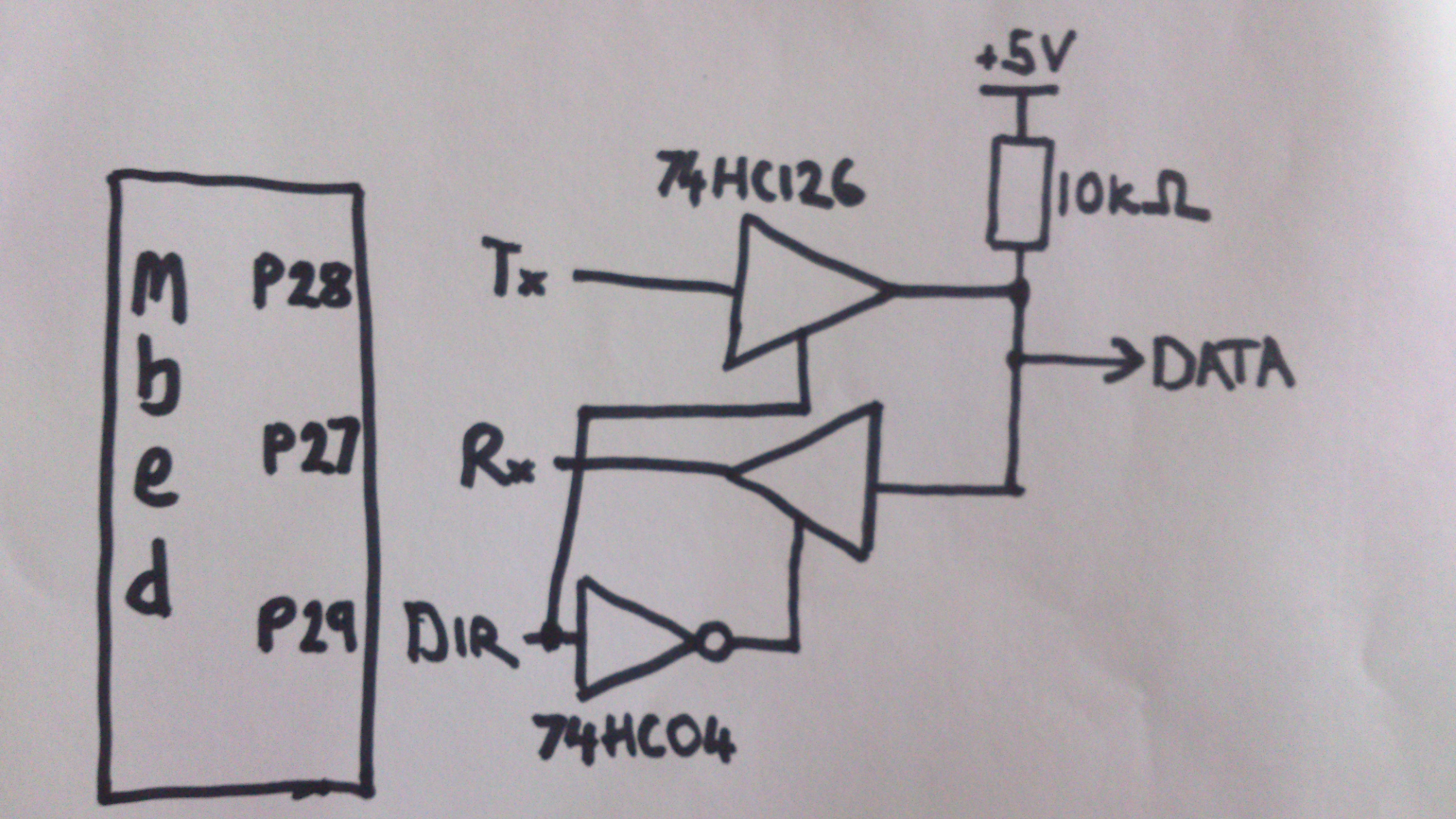A library for the AX-12+ servo using external ICs instead of the SerialHalf-Duplex class
A library based on the AX-12+ library but using external hardware to convert from full to half duplex as suggested in the AX-12 datasheet. The buffers and NOT gate need to connected as shown below.

Don't forget the pull-up resistor!
AX12.cpp
- Committer:
- ms523
- Date:
- 2012-10-07
- Revision:
- 2:3000c6778d1c
- Parent:
- 1:1dd9cd18975d
File content as of revision 2:3000c6778d1c:
/* mbed AX-12+ Servo Library - External hardware version */
#include "AX12.h"
#include "mbed.h"
AX12::AX12(Serial& bus, PinName dir, int ID)
: _bus(bus), _dir(dir) {
_bus.baud(1000000);
_ID = ID;
_dir = TRANSMIT;
}
int AX12::SetGoal(int degrees) {
char data[2];
short goal = (1023 * degrees) / 300; // 1023 / 300 * degrees
data[0] = goal & 0xff; // bottom 8 bits
data[1] = goal >> 8; // top 8 bits
int rVal = write(_ID, AX12_REG_GOAL_POSITION, 2, data); // write the packet, return the error code
return(rVal);
}
float AX12::GetPosition(void) {
char data[2];
int ErrorCode = read(_ID, AX12_REG_POSITION, 2, data);
short position = data[0] + (data[1] << 8);
float angle = (position * 300)/1024;
return (angle);
}
//********************************************************************************************
// Method used to read data from the regiesters of the AX-12+ Servo
//********************************************************************************************
int AX12::read(int ID, int start, int bytes, char* data) {
char TxBuf[16];
char sum = 0;
char Status[16];
// Build the TxPacket first in RAM, then we'll send in one go...
TxBuf[0] = 0xff; // Header byte 1
TxBuf[1] = 0xff; // Header byte 2
TxBuf[2] = ID; // ID byte
TxBuf[3] = 0x04; // Packet Length (always 4 bytes)
TxBuf[4] = 0x02; // Instruction byte (READ - Section 4.2 on datasheet)
TxBuf[5] = start; // First AX-12 reg Address to read from (Parameter 1)
TxBuf[6] = bytes; // Bytes to read
//Work out checksum...
sum += TxBuf[2];
sum += TxBuf[3];
sum += TxBuf[4];
sum += TxBuf[5];
sum += TxBuf[6];
TxBuf[7] = 0xFF - sum;
// And send the packet to th AX-12+ Servo...
_dir = TRANSMIT; // Switch the hardware to transmit...
for (int i = 0; i < 8 ; i++) { // Transmit the packet in one burst with no pausing
_bus.putc(TxBuf[i]);
}
wait (0.00004); // Wait for data to transmit
_dir = RECEIVE; // Switch the hardware back to receive...
//********************************************************************************************
// Now we should get a response back from the AX-12+ servo...
//********************************************************************************************
Status[4] = 0xFE; // Initailise status[4] return code
if (_ID!=0xFE) { // We'll only get a reply if it was not broadcast
for (int i=0; i<(6+bytes) ; i++) { // Receive the Status packet 6+ number of bytes read
Status[i] = _bus.getc();
}
for (int i=0; i < Status[3]-2 ; i++) { // Copy the data from Status into data for return
data[i] = Status[5+i];
}
} // if (ID!=0xFE)
return(Status[4]);
}
//********************************************************************************************
// Method used to write data into the regiesters of the AX-12+ Servo
//********************************************************************************************
int AX12:: write(int ID, int start, int bytes, char* data) {
// Format is - 0xff, 0xff, ID, Length, Intruction(write), Reg Address, Param(s), Checksum
char TxBuf[16];
char sum = 0;
char Status[6];
// Build the TxPacket first in RAM, then we'll send in one go...
TxBuf[0] = 0xff; // Header byte 1
TxBuf[1] = 0xff; // Header byte 2
TxBuf[2] = ID; // ID byte
TxBuf[3] = 3+bytes; // Packet Length byte
TxBuf[4] = 0x03; // Instruction byte (WRITE - Section 4.1 on datasheet)
TxBuf[5] = start; // First AX-12 reg Address to write to (Parameter 1)
for (char i=0; i<bytes ; i++) { // Data to be written (Parameters 2 - N+1)
TxBuf[6+i] = data[i];
sum += TxBuf[6+i];
}
//Work out checksum...
sum += TxBuf[2];
sum += TxBuf[3];
sum += TxBuf[4];
sum += TxBuf[5];
TxBuf[6+bytes] = 0xFF - sum;
// And send the packet to th AX-12+ Servo...
_dir = TRANSMIT; // Switch the hardware to transmit...
for (int i = 0; i < (7 + bytes) ; i++) { // Transmit the packet in one burst with no pausing
_bus.putc(TxBuf[i]);
}
wait (0.00004); // Wait for data to transmit
_dir = RECEIVE; // Switch the hardware back to receive...
//********************************************************************************************
// Now we should get a response back from the AX-12+ servo...
//********************************************************************************************
Status[4]=0x00; // Initailise status[4] to get correct response
if (_ID!=0xFE) { // We'll only get a reply if it was not broadcast
for (int i=0; i < 6 ; i++) { // Response is 6 bytes - 0xFF, 0xFF, ID, Length Error, Param(s) Checksum
Status[i] = _bus.getc();
}
} // if (ID!=0xFE)
return(Status[4]); // return error code - if no error will return 0x00
}